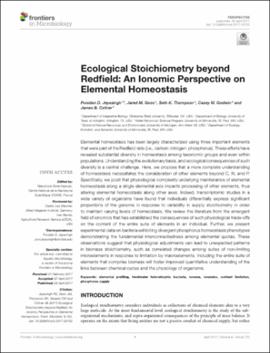| dc.contributor.author | Jeyasingh, Punidan D. | |
| dc.contributor.author | Goos, Jared M. | |
| dc.contributor.author | Thompson, Seth K. | |
| dc.contributor.author | Godwin, Casey M. | |
| dc.contributor.author | Cotner, James B. | |
| dc.date.accessioned | 2019-08-28T16:00:45Z | |
| dc.date.available | 2019-08-28T16:00:45Z | |
| dc.date.issued | 2017-04-25 | |
| dc.identifier | oksd_jeyasingh_ecologicalstoic_2017 | |
| dc.identifier.citation | Jeyasingh, P. D., Goos, J. M., Thompson, S. K., Godwin, C. M., & Cotner, J. B. (2017). Ecological stoichiometry beyond Redfield: An ionomic perspective on elemental homeostasis. Frontiers in Microbiology, 8, Article 722. https://doi.org/10.3389/fmicb.2017.00722 | |
| dc.identifier.uri | https://hdl.handle.net/11244/321364 | |
| dc.description.abstract | Elemental homeostasis has been largely characterized using three important elements that were part of the Redfield ratio (i.e., carbon: nitrogen: phosphorus). These efforts have revealed substantial diversity in homeostasis among taxonomic groups and even within populations. Understanding the evolutionary basis, and ecological consequences of such diversity is a central challenge. Here, we propose that a more complete understanding of homeostasis necessitates the consideration of other elements beyond C, N, and P. Specifically, we posit that physiological complexity underlying maintenance of elemental homeostasis along a single elemental axis impacts processing of other elements, thus altering elemental homeostasis along other axes. Indeed, transcriptomic studies in a wide variety of organisms have found that individuals differentially express significant proportions of the genome in response to variability in supply stoichiometry in order to maintain varying levels of homeostasis. We review the literature from the emergent field of ionomics that has established the consequences of such physiological trade-offs on the content of the entire suite of elements in an individual. Further, we present experimental data on bacteria exhibiting divergent phosphorus homeostasis phenotypes demonstrating the fundamental interconnectedness among elemental quotas. These observations suggest that physiological adjustments can lead to unexpected patterns in biomass stoichiometry, such as correlated changes among suites of non-limiting microelements in response to limitation by macroelements. Including the entire suite of elements that comprise biomass will foster improved quantitative understanding of the links between chemical cycles and the physiology of organisms. | |
| dc.format | application/pdf | |
| dc.language | en_US | |
| dc.publisher | Frontiers Media | |
| dc.rights | This material has been previously published. In the Oklahoma State University Library's institutional repository this version is made available through the open access principles and the terms of agreement/consent between the author(s) and the publisher. The permission policy on the use, reproduction or distribution of the material falls under fair use for educational, scholarship, and research purposes. Contact Digital Resources and Discovery Services at lib-dls@okstate.edu or 405-744-9161 for further information. | |
| dc.title | Ecological stoichiometry beyond Redfield: An ionomic perspective on elemental homeostasis | |
| osu.filename | oksd_jeyasingh_ecologicalstoic_2017.pdf | |
| dc.description.peerreview | Peer reviewed | |
| dc.identifier.doi | 10.3389/fmicb.2017.00722 | |
| dc.description.department | Integrative Biology | |
| dc.type.genre | Article | |
| dc.type.material | Text | |
| dc.subject.keywords | elemental profiling | |
| dc.subject.keywords | freshwater heterotrophic bacteria | |
| dc.subject.keywords | ionome | |
| dc.subject.keywords | ionomics | |
| dc.subject.keywords | nutrient limitation | |
| dc.subject.keywords | phosphorus supply | |
